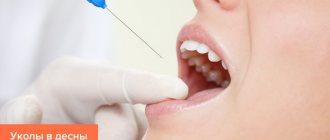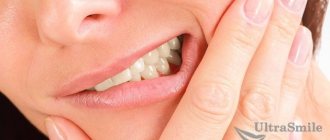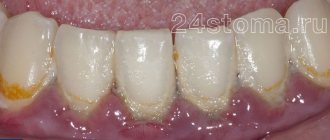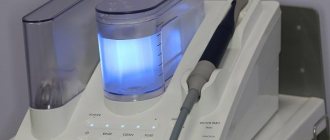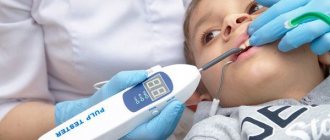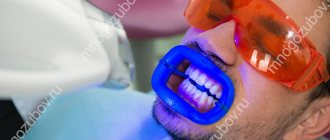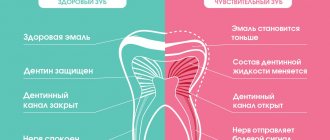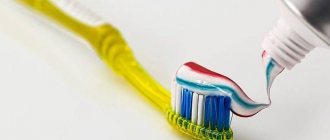Dental periodontitis - what is it?
Periodontium refers to the whole complex of tissues responsible for tooth retention: connective fibers, blood vessels, periodontium, gums, canals and jaw bone. Periodontitis is an inflammation of the gum tissue, which quickly affects the rest of the complex. As a result, the dentogingival connection is disrupted and the tooth falls out. Periodontitis is a very common disease that affects more than 95% of the world's inhabitants in various stages: from the rudimentary form of periodontitis to advanced, untreatable.
It is believed that most often the pathology manifests itself in men and women aged 30 to 40 years and in adolescents 16-18 years old. However, the disease can affect anyone, regardless of gender and age, if you do not monitor the condition of your oral cavity and postpone a visit to the dentist. Periodontitis can be treated only in the early stages; when it becomes chronic, no dentist, even the most modern, can cope with it, since the tissues have undergone irreversible changes.
ARE THERE METHODS FOR PREVENTION OF PERIODONTAL DISEASES?
- Prevention of periodontal disease consists of several simple points:
- Brush your teeth 2 times (morning and evening) after meals. Use a toothpaste recommended by your doctor to protect your gums. Use an electric toothbrush - it perfectly cleans your teeth and massages your gums.
- Do professional oral hygiene at least 2 times a year, and at the same time you can undergo an examination by a periodontist. Do not use any medications for the treatment or prevention of periodontal disease (gels, ointments, tablets, etc.) without consulting your dentist.
- Do not eat only soft and delicate foods - your teeth should receive normal, natural stress.
- Your diet should be well balanced, contain the required amount of proteins, fats, carbohydrates, and vitamins. If you are deficient in vitamins, take multivitamin complexes.
- Lead a healthy lifestyle.
Etiology of periodontitis
Periodontitis can be caused by various factors.
- Microbes.
The oral cavity of any person is inhabited by pathogenic microorganisms that do not cause harm if proper nutrition and hygiene are observed. But, if the patient constantly consumes carbohydrates and neglects to use dental floss, bacteria actively develop and gradually affect the enamel, dentin and reach the periodontal tissues. - Genetic predisposition.
If for many generations all family members have suffered from this disease, there is a high probability of adopting this predisposition. Heredity plays a big role in the development of gum periodontitis, even if a person carefully monitors hygiene and eats right. - Mechanical damage to the gums.
Tissue bruise due to negligence, an incorrect bite, in which increased pressure is applied to a specific area of the gum, or an oversized filling, due to which the tooth puts increased pressure on the gum and damages it. - Systemic diseases.
Dental diseases and periodontitis can cause pathologies not related to the oral cavity, such as vegetative-vascular dystonia, HIV, diabetes mellitus, hypertension and gastrointestinal diseases. - Autoimmune diseases.
Reduced immunity, disruption of the endocrine system, hormonal imbalances during pregnancy. - Poor quality dentist work.
Tissue damage during treatment, an unsuitable crown, incorrectly installed braces and other tissue injuries due to the fault of the doctor can provoke periodontitis.
Among the given factors are microbial causes of the development of periodontitis, and microbes are known to be transmitted from one person to another. So is periodontitis contagious? No, directly, for example, by airborne droplets or through saliva, it is impossible to become infected with the pathology, and every person has microbes that provoke the disease - even if periodontitis bacteria are transmitted from a sick person to a healthy person, the microbes will not develop without additional favorable circumstances: poor oral hygiene, gum injuries, predisposition or concomitant diseases.
Serious indications for tooth extraction
In each individual case, a decision is made by the attending physician, who is based on the general picture of the disease and the patient’s medical history, studies performed, and proceeds from the chosen tactics and method of treatment.
So, for example, if the patient is indicated and ready for dental implantation, the specialist will most likely suggest that all diseased teeth be removed first. The news of the need to undergo such a procedure seems frightening to many patients (after all, the teeth appear normal in appearance). But here we need to pay attention to several key points. When restoring teeth susceptible to periodontitis using the implantation method, it is important to pay attention to the following point: you must first remove damaged teeth on both jaws. If the patient plans to carry out treatment, for example, only on the upper jaw, then if problems in the lower jaw are ignored, the function and normal functioning of the jaw joint will be disrupted, the bite will not be corrected, the chewing load will change, and accordingly, the problems will not be solved, only the aesthetics of the smile will improve. To ensure that you are not disappointed by the result of the treatment, we recommend integrated approaches, for example, implantation can be done from above, and from below, if there are problems, temporary removable or conditionally removable dentures can be installed. But if there is inflammation in the oral cavity, especially progressive inflammation, it needs to be eliminated.
Diseased teeth may only appear healthy on the outside
You assess their condition by their appearance, but the doctor bases it on their functionality and the risk they pose to neighboring teeth and to the body as a whole. You may not have noticed that the diseased teeth have become mobile, that they are loosening, and periodontitis has already entered an advanced stage, fraught with the complications described above. Based on examinations, studies and computed tomography, the doctor will be able to make a diagnosis with maximum accuracy.
If there is a source of inflammation, installation of implants is not advisable
Placing implants in the presence of inflammation in the mouth is an unjustified risk for your health and wallet. After all, the inflammatory process from diseased teeth can spread to implants at any time and lead to peri-implantitis and their rejection in the very near future, i.e. during the rehabilitation period. Also, danger may await the patient in the long term, since bacteria in the mouth and constantly worsening inflammation will provoke atrophy of the bone tissue around the installed artificial root, which will cause the top of the implant to become exposed and will look extremely unaesthetic. As a result, you risk losing the entire structure on the implants and will need re-treatment.
If the patient, for certain reasons - state of health, moral component, financial capabilities - is not ready for implantation, which in case of periodontitis (especially in advanced stages) is the most optimal and high-quality solution to the problem, then the doctor can temporarily save the teeth and carry out a set of other therapeutic events. Implantation against the backdrop of such a process is a risky business, so it would be better to give preference to removable structures.
Symptoms of periodontitis in adults and children
Typically, the signs of periodontitis vary depending on the stage of development of the disease, but there are also general symptoms characteristic of the entire period of pathology:
- unpleasant constant bad breath, plaque and tartar are associated with the active activity of bacteria;
- bleeding and brighter gum color due to tissue inflammation;
- increased sensitivity of teeth, pain when chewing;
- thick viscous saliva;
- swollen lymph nodes;
- headache, weakness and lethargy.
Preventive actions
Prevention is the best way to avoid tissue destruction and other serious consequences. This applies to both sick and healthy people. It is enough to follow simple rules and you will not have to treat periodontitis.
What do we have to do:
- brush your teeth twice a day;
- rinse the mouth after eating;
- correct the bite, which can cause the development of pathology;
- undergo a dental examination every six months;
- For dental treatment and prosthetics, go to a dental clinic with a good reputation (you can read patient reviews);
- include fresh vegetables and fruits in the diet, limit the consumption of sweets;
- quit smoking.
Stages of periodontitis
With each stage, dental periodontitis develops more strongly. Unfortunately, most often patients consult a doctor already with a severe form of the disease.
Mild periodontitis
There is bleeding of the gums when brushing teeth, small periodontal pockets up to 3 mm deep, slight swelling of the gums and discoloration - the tissues look loose and slightly blue. The initial stage is almost painless and can be treated in just a couple of visits to the dentist.
Moderate periodontitis
The gums bleed almost constantly, and small purulent discharge appears. Gum pockets enlarge and expose the roots of the teeth, and the interdental spaces widen. The patient feels the tooth bursting and increased pressure on the gum tissue. It is difficult to cure moderate periodontitis, but it is quite possible if you make an effort and follow the doctor’s instructions.
Severe periodontitis
The gums are completely weakened, the tissues are loose, there is no swelling. Severe tooth mobility and even tooth loss. Bone tissue with severe periodontitis becomes thinner and atrophies. The entire complex is affected - ligaments, muscles, periodontal tissues and blood vessels, and nutrition of the tooth stops. The only thing a specialist can do at this stage is to relieve gum inflammation and recommend tooth extraction for prosthetics.
Medical Internet conferences
Review of modern methods of treatment of generalized aggressive periodontitis
Shcherbakova T.A. – 4th year, Faculty of Dentistry
Scientific supervisors – associate, Ph.D. Petrova A.P., ass. Venatovskaya N.V.
FSBEI HE "Saratov State Medical University named after. IN AND. Razumovsky" of the Ministry of Health of the Russian Federation
Department of Pediatric Dentistry and Orthodontics
Summary. This article discusses modern methods of treatment (conservative and surgical) for generalized aggressive periodontitis (GAgP) in the clinical practice of a dentist.
Key words: generalized aggressive periodontitis, periodontal diseases.
Responsible author: Shcherbakova Tatyana Alekseevna,
Modern methods of treatment of generalized aggressive periodontitis
Shcherbakova TA – student of the 4th course of dental faculty
Razumovsky Saratov State Medical University
Pediatric Dentistry and Orthodontics department
Summary. This article describes the modern methods of treatment (conservative and surgical) generalized aggressive periodontitis in clinical practice dentist.
Keywords: generalized aggressive periodontitis, dental, periodontal disease.
Relevance. Aggressive periodontitis is a type of periodontal disease characterized by fulminant destruction of the periodontal ligament and loss of alveolar bone mass, which usually occurs in young people, less often in patients of older age groups [1]. According to the classification of periodontal diseases, adopted at a meeting of the presidium of the periodontology section of the Russian Dental Association in 2001, this disease was included in an independent group of periodontal diseases - aggressive forms of periodontitis. However, practicing dentists more often turn to the ICD-C-3 classification of dental diseases based on ICD-10 (WHO, 1995), according to which aggressive periodontitis corresponds to code K 05.4 “Periodontal disease”. Based on research conducted by the Department of Periodontology, Wonkwang University School of Dentistry, Iksan, Korea, the incidence of aggressive periodontitis in a study population of 1,692 patients (1,020 men (60.3%) and 672 women (39.7%) was 28 cases (1.65%) There were no significant differences between the percentage of male and female patients. The generalized form was more common than the localized form in a ratio of 27:1. The mean age was 34.5 years [2]. Even so that the prevalence of aggressive periodontitis is significantly lower than other periodontal diseases, such an immutable risk factor as a strong genetic predisposition causes significant difficulties in the process of its treatment. The lack of early diagnosis and timely treatment in patients with this disease in a short time can lead to rapid destruction of periodontal tissue and tooth loss [3].There are specific diagnostic signs, but their clinical manifestations may vary between patients. If the disease is diagnosed in advanced stages, successful treatment is challenging. There is a wide variety of treatment options available today, with fairly variable success rates. However, research in this area is growing at an exponential rate and treatment options such as tissue engineering and genetic technologies are promising for this disease.
Purpose: to find out the feasibility of various methods of treatment of generalized aggressive periodontitis (GAgP) according to literature sources.
Tasks:
1. Characterize the main clinical signs of generalized aggressive periodontitis.
2. Consider the basic principles of treatment of the pathology being studied.
3. Find out the effectiveness of non-surgical treatment for GAgP
Materials and methods. An analysis of scientific articles in Russian and English was carried out, a review of modern educational publications on the topic of types of periodontal diseases and methods of their treatment was carried out.
Results and discussion. When faced with this pathology in clinical practice, it is necessary to take into account that generalized aggressive periodontitis is a multifactorial disease in which microbiological, genetic, immunological and behavioral factors are integrated. They determine the onset, course and severity of the disease. The presence of bad habits, such as smoking, or an unsatisfactory level of oral hygiene in patients causes more massive periodontal destruction compared to those who maintain a satisfactory level of oral health.
The disease has a wave-like course with periods of exacerbation and remission. This causes the presence of two different clinical pictures during the examination. During the period of remission, patients do not present any complaints, the gums are pink, but probing reveals deep periodontal pockets. The absence of visible signs of an inflammatory reaction, despite the presence of deep periodontal pockets and disruption of the tooth-gingival junction, together with the complete physical health and young age of the patients, is a characteristic feature of aggressive periodontitis, which is detected at this stage of the disease. Periods of remission can last from several weeks to several months or years, accompanied by periods of exacerbation of the disease. During the acute phase, progressive destruction of the alveolar bone and loss of the periodontal junction occurs. At this stage, during a clinical medical examination, the gums have all the signs of inflammation from mild to severe. Inflammatory gum hypertrophy is common. When probing with a calibration probe, bleeding is typical in six areas around each tooth or even spontaneous release of purulent exudate. Most patients consult a dentist at this stage of the disease.
The prognosis of treatment largely depends on a timely diagnosis. Early diagnosis of the disease helps prevent its progression and avoid serious loss of alveolar bone mass. In addition, since aggressive periodontitis tends to run in families, it is necessary to screen close relatives for early diagnosis of the disease in other family members [4].
Conservative treatment remains the primary method of antibacterial therapy for generalized aggressive periodontitis . In the initial stages of the disease, when the destruction of the periodontal joint and bone is mild to moderate in severity, treatment of the disease is based on the use of systemic antibiotics in combination with mechanical therapy. Treatment should begin with an attempt at complete elimination or bacteriostatic action on etiological factors and modifiable risk factors. It should be borne in mind that the disease has a strong genetic predisposition. The response of the human body to pathogenic microorganisms in dental plaque plays a significant role in its pathogenesis and expression. This response is determined genetically and is an unchangeable risk factor for the pathology in question [5]. However, the disease is also dependent on microbial and environmental factors, and can therefore be successfully controlled in susceptible individuals, indicating the absolute importance of timely removal of dental plaque at home by the patient or the doctor at a dental appointment. In patients susceptible to the disease, even a small amount of dental plaque can provoke a humoral and cellular immune response. Mechanical removal of plaque from the tooth surface can be achieved by teaching and motivating the patient in proper oral hygiene through a visual demonstration on a mock-up of teeth brushing using the modified Bass method (for patients without gum recession) and the modified Stillman method (for patients with hyperesthesia). Also, the use of auxiliary cleaning hygiene items for interdental spaces (floss, interdental brushes, brushes) will ensure effective treatment of the most inaccessible areas of the oral cavity. Regular visits to the dentist to monitor the effectiveness of plaque control are important. For further control, oral rinsing with 0.12% or 0.2% chlorhexidine or 1% povidone iodide may be recommended as an addition to mechanical measures [6]. Aminofluoride and tin fluoride in rinses and toothpastes are also effective in combating supragingival plaques in aggressive periodontitis. In addition, the use of fluoride as a mouth rinse is recommended for remineralization of exposed root surfaces, and also as a desensitizing agent in patients with complaints of dental hypersensitivity [7]. It has been scientifically proven that smoking is a significant risk factor and leads to a more severe course of the disease. The effectiveness of conservative and surgical treatment and regenerative therapy in such individuals is significantly less than in non-smoking patients. Therefore, the doctor at the dental appointment should inform about the effect of smoking on the periodontal condition and the benefits of quitting it [8].
One of the options for conservative mechanical antimicrobial therapy is Scaling & Root Planing (SRP) - a method of instrumental removal of supra/subgingival dental plaque and tartar, leveling the surface of the tooth root, used by clinicians as etiotropic therapy for periodontitis. For this purpose, it is possible to use manual instruments, mainly curettes and scalers, as well as air abrasive systems and fine-grained diamond burs. Scaling and Root Planning are carried out sequentially in one visit. After the intervention, the surface of the crown and root should be hard, clean and free of micro-roughness. SRP is one of the most commonly used bacterial reduction procedures and is considered by many physicians to be the gold standard of treatment [9]. However, this method does not ensure the complete destruction of pathogenic microorganisms and their metabolic products from periodontal pockets. There is a pattern: the deeper the periodontal pocket is revealed during probing, the lower the effectiveness of SRP [10]. An alternative to mechanical antimicrobial therapy was proposed by Quirynen and represents a single-phase disinfection of the entire oral cavity. This method leads to a significant improvement in the clinical situation of the initial stages of periodontitis, compared with the isolated use of SRP. It involves complete sanitization of the oral cavity, carried out by brushing the tongue with a 1% chlorhexidine solution for 1 minute, removing dental plaque, rinsing the mouth with a 0.2% chlorhexidine solution for 2 minutes, as well as irrigating periodontal pockets with a 1% chlorhexidine solution . Careful precautions are necessary, since high concentrations of chlorhexidine in sensitized patients can cause an individual reaction in the form of contact dermatitis, itching and urticaria. The effect of topical use of chlorhexidine during pregnancy and lactation has not been studied, so the antiseptic should be used only in extreme cases. The effect of the drug in pediatric practice has also not been studied; therefore, it is not recommended for use in children under 18 years of age. In general, the treatment modality is selected based on the specific clinical situation and patient preferences [11].
Photodynamic therapy and laser irradiation are additional methods to the main therapy for inhibiting pathogenic bacteria in periodontal pockets [12]. An effective and atraumatic method of treatment is the use of lasers, since they have bactericidal and detoxifying effects. This is due to a number of factors: improvement of regional blood flow in the area of the pathological focus, increased chemotaxis of leukocytes to the area of inflammation and activation of proteolytic enzymes, which have a detrimental effect on microbes. The most widely used are helium-neon gas and gallium arsenide semiconductor lasers. The light they emit is effectively absorbed by the cells of the mucous membranes and has a greater depth of penetration into the tissue. Laser devices of the AL-010 and SOFT-LASER series are convenient to use [13, 31].
Photodynamic therapy (PDT) is also a non-invasive infection control approach that combines laser energy with a photosensitizer to produce singlet oxygen molecules and free radicals that are effective in killing bacterial cells. PDT has high clinical success rates and a number of advantages such as: reduction of treatment time for subgingival areas, destruction of microorganisms within a short period of time, absence of the need for anesthesia and damage to adjacent tissues, as well as the development of resistant forms of bacteria [14]. In recent years, these modern methods have shown themselves to be a promising direction, popular among doctors, as a non-surgical treatment for generalized aggressive periodontitis. The combined use of SRP, PDT and laser irradiation shows greater clinical effectiveness compared to monotherapy. During the initial stages of treatment, regular visits to the dentist can assess the patient's response to non-surgical therapy [15].
Systemic antibiotic therapy. The use of systemic antibiotics is an integral part of the treatment of aggressive periodontitis, since pathogenic bacteria, such as Aggregatibacter actinomycetem-comitans and Porphyromonas gingivalis, cannot be completely destroyed using other methods [16]. Previously, tetracycline antibiotics were widely used to achieve this goal. They have the ability to concentrate in periodontal tissues and inhibit the growth of A. actinomycetem-comitans. In addition, tetracyclines inhibit collagenase, reducing tissue destruction and facilitating bone regeneration [17]. But the development of resistance to them has led to the use of other pharmacological groups as combination or sequential therapy. The current preferred combination is amoxicillin 250 mg three times daily with metronidazole 250 mg twice daily for 8 days. This is one of the most effective combinations of drugs, which has enough evidence for this [18]. With therapeutic treatment in the initial stages of the disease, antibiotic therapy significantly improves overall treatment results. Identification of the species of bacteria and their sensitivity to antibiotics is not mandatory, since the combinations described above may be clinically and economically more beneficial. The use of only one drug (doxycycline, azithromycin, metronidazole and clindamycin) produces results when used in addition to SRP. The choice of antibiotic is made based on numerous criteria - possible allergic reactions on the part of the patient, concomitant pathologies, medical history [19].
Topical antimicrobial agents are also a necessary component of the therapeutic treatment of aggressive periodontitis, especially if there is limited accumulation of exudate, deep periodontal pockets and lack of adequate response to mechanical therapy and the use of systemic antibiotics. The main advantage of using this method is the delivery of smaller doses of drugs to the periodontal pocket, while the concentration of the active substance at the site of infection is maintained at a high level. This avoids side effects typical of systemic antibacterial agents.
In addition, this option is applicable in case of intolerance to systemic administration of drugs. Recently, drugs with gradual and slow release of the active ingredient have been used. The decision to use topical anti-infective adjunctive therapy remains a matter of individual clinical judgment, treatment phase, and patient status and choice [20].
A review of the literature and scientific research on the topic of non-surgical treatment of generalized aggressive periodontitis showed that this pathology can be successfully treated with therapeutic methods. Since such treatment leads to the cessation of disease progression, resolution of inflammation, reduction in the depth of periodontal pockets, and significant reconstruction of alveolar defects. Based on these data, the treatment plan should begin with primary or additional mechanical antimicrobial therapy in combination with systemic antibiotics. It is recommended that antibiotic therapy be started 24 hours before SRP or other mechanical plaque removal methods and continued concurrently with these procedures. After 4-6 weeks, the patient's oral health is re-evaluated. If there are no significant changes in the initial stages of therapy, the doctor may repeat the treatment using different combinations of antibiotics and possible treatments. If there is no effect, you should proceed to surgical treatment [21].
Surgical treatment of generalized aggressive periodontitis is a set of measures aimed at preventing further tissue damage and bone loss in the event of late diagnosis or ineffective therapeutic intervention. In order to minimize undesirable consequences, it is possible to use alternative laser surgery. With extensive loss of periodontal tissue, surgical treatment can lead to increased tooth mobility and a worsening of the clinical situation as a whole. Therefore, a careful assessment of risk factors and benefits for a specific individual situation is necessary [22]. Currently, restorative surgical treatment is based on the regeneration of the anatomical form and function of the periodontium. Replacement bone grafts, guided tissue regeneration (GTR) and biological modifiers (growth and differentiation factors, extracellular matrix proteins) are widely used.
In order to eliminate pathological pockets, it is rational to perform flap operations on soft tissues. The repositioned flap (modified Widmann flap) and the technique of tilting the flap while preserving the gingival papilla are the methods of choice in the practice of the dentist. The combination of surgical treatment with the use of systemic antibiotics leads to a more intensive reduction in microbial load and pocket depth.
Bone destruction, which occurs quickly in aggressive periodontitis, is a particular problem and requires immediate attention from a physician. There are two methods with the most successful treatment outcomes: bone transplantation and guided tissue regeneration. The dental materials market represents a wide range of transplantation materials, including autografts, allografts, xenoimplants and alloplasties. In the process of autotransplantation, material obtained from one anatomical site is transplanted to another within the same organism. Autogenous transplants are considered the standard and have excellent regenerative properties, which have been scientifically proven by histological examination. Additional benefits include eliminating the risk of spreading the disease, eliminating the immune response, and reducing the cost of surgery. The main limitations associated with the use of autografts in periodontal regeneration are the limited amount of bone tissue that can be transferred, coupled with a high risk of developing pathological processes at the donor site [23]. Currently, advances in the field of tissue engineering and biomaterials technology provide a large number of options for the treatment of bone defects, so doctors are striving to use alloimplants, xenoimplants and alloplastic bone substitutes in their practice. The transplantation of bone tissue between two genetically different organisms is called alloimplantation. Bone allografts are unique in that they typically have the cellular component removed to reduce the risk of rejection. In addition, they are carefully processed to eliminate any possibility of disease transmission. Clinical studies confirm the favorable outcome of treatment using these materials. In terms of filling intraosseous defects, more than 50% of them are completely resolved [24]. The use of animal-derived materials for human tissue repair relies on the use of either bovine or coral material. These types of implants are called xenoimplants. The combination of bovine material with purified porcine collagen or synthetic polypeptide (PepGen P-15) stimulates regeneration and leads to the formation of a healthy periodontal ligament. Due to the low allergenicity and biodegradation of collagen, it has good tissue compatibility. Collagen preparations reduce inflammatory reactions and shorten wound healing time [25]. Synthetic bone substitutes include osteoconductive polymers in the form of blocks, granules, cements, or osteoinductive proteins. Proteins stimulate osteogenesis, cementogenesis and periodontal ligament growth, and osteoconductors provide a passive matrix for new bone. Hydroxyapatite, beta-tricalcium phosphate, and bioactive glass are the most commonly used alloplastic materials [24].
The principle of directed tissue regeneration is based on the use of membranes that prevent the migration of gingival epithelium and the growth of granulation tissue, which allows specific poorly differentiated cells of the periodontal ligament to form a new connective tissue attachment. The membrane can be produced from biological preparations or from the patient’s blood. One of the most commonly used is a membrane made of stretched polytetrafluoroethylene. Many experimental and clinical studies have proven the effectiveness of using membrane technology in conjunction with planting materials. This method is being actively improved, membrane production technologies are being improved, but today guaranteed efficiency can only be found in the case of 3-wall defects [26].
The use of biological mediators (insulin-like growth factor, platelet-derived growth factor, platelet-rich plasma) and extracellular proteins leads to improved clinical and radiological parameters. Platelet-rich plasma promotes the restoration of lost periodontal tissue, as platelets play a critical role in wound healing [27]. They promote initial coagulation at the wound site, as well as the release of growth factors. The main strategy of this method is to enhance and accelerate the effect of growth factors contained in platelets, which are universal initiators of the regeneration of all wounds. Plasma platelets also contain fibrinogen, fibronectin and vitronectin, which promote osteoconduction, acting as matrices for bone and connective tissue repair [28].
Treatment of generalized aggressive periodontitis is a challenging goal because it requires a multidisciplinary approach. When diagnosed at a late stage, the chance of tooth loss is up to 60%. Losing teeth at a young age can lead to psychological trauma and changes in a person's behavior. In this case, the solution to cosmetic problems is possible through combined periodontal and orthodontic therapy [29], prosthetics [30], and implant treatment. In order to maintain optimal treatment results and prevent relapses, maintenance therapy is necessary and continues throughout life. Psychotherapy also has a positive effect and should be started immediately after the first consultation with a dentist and continued depending on the psychological state of the patient [31,32].
Conclusions:
1. A characteristic feature of generalized aggressive periodontitis is the rapid destruction of periodontal tissue. The disease most often affects young people with no concomitant systemic diseases.
2. The main goal of treatment is to reduce or eliminate subgingival microorganisms, restore lost tissue and maintain periodontal health.
3. It is traditionally believed that GAgP has a poor prognosis and only radical treatment is advisable in such a situation. Modern treatment regimens for generalized aggressive periodontitis must take into account the importance of early diagnosis and the validity of combining various techniques; only in this case can we count on long-term stabilization of periodontal health.
Forms of periodontitis
Types of periodontitis are classified into groups according to different criteria.
By place of development:
- localized - a small lesion affecting only one tooth, and sometimes part of the tooth, for example the root; most often occurs due to mechanical damage to tissue;
- generalized - the damage spreads to a group of teeth, gum and bone tissue, so it seems that half of the jaw hurts; A common cause is the development of bacteria and reduced immunity.
According to the nature of the course:
- acute - pain during periodontitis occurs suddenly, symptoms develop rapidly;
- chronic - advanced periodontitis of the acute stage becomes chronic, pain and other symptoms practically disappear, but the disease continues to progress and destroy tissue.
Reasons for the development of generalized periodontitis
The precursors to the formation of the disease are some exogenous and endogenous factors. The first group is small; most of the diseases of this system are provoked precisely by the internal state of the body. All etiological factors are classified into local (plaque, tartar, problems with bite, abnormal position of teeth, strands of the mucous membrane) and general (diseases of the body - diabetes mellitus, goiter of toxic origin, excess weight, hypovitaminosis, hepatitis, gastritis, etc. ). All this one way or another affects the condition of the periodontium and leads to a deterioration in its functioning.
Microbiological studies have been able to prove the fact that the leading role in the development of this condition is given to microorganisms called Prevotella Intermedia, Bacteroides forsythus, Peptostreptococcus, etc. In order for the dental system to be protected from their influence, protection in the form of plaque is provided in the dental plaque , accumulated in the gingival sulcus, periodontal pockets, and tooth roots.
The life products of pathogenic organisms contribute to the activation of the secretion of certain substances (prostaglandins, cytokines, enzymes), which lead to the destruction of periodontal tissue structures. Factors that entail a decrease in local and general protection from the influence of pathogenic bacteria include:
- smoking,
- radiation damage,
- ignoring the rules of personal hygiene regarding the oral cavity.
The development of this condition is usually preceded by inflammation of the gingival margin, which entails disruption of the connection, destruction of the ligamentous apparatus, and resorption of the alveolar bone. These changes lead to pathological mobility of teeth, overload of their individual groups, and occlusion. In the absence of adequate therapy, this disease provokes tooth loss or removal, as well as problems with the functioning of the jaw system as a whole.
Exacerbation of periodontitis
The disease does not occur in isolation; periodontitis affects the condition of the entire organism. Even if the pathology has passed from an acute form to a chronic one and it seems to the patient that the pain has gone away and the illness has receded, the destructive effect of the inflammatory process still continues. And the advanced chronic stage can not only worsen, but also cause severe complications of periodontitis:
- osteomyelitis - inflammation of bone tissue;
- abscess and phlegmon - the formation of abscesses and the spread of pus through the tissues;
- lung diseases - pathogenic bacteria from the oral cavity enter the lungs when breathing;
- pathologies of the heart and blood vessels - a long-term inflammatory process affects the functioning of the heart.
WHAT IS MEAN BY PERIODONTAL TREATMENT
After collecting all the necessary information, the periodontist will discuss the condition of your gums with you and suggest the most optimal treatment. Most importantly, it must be comprehensive - that is, treatment must cover all identified causes and associated factors that support the disease. Only in this case can it be possible to completely cure or stabilize periodontal disease for a long time.
Treatment will be much more effective if the patient strictly follows all instructions and strictly follows the chosen treatment plan.
Typically, a comprehensive treatment plan consists of general and local treatment and includes all or part of the methods listed below.
Diagnosis of periodontitis
Diagnostics includes a visual examination to determine the presence of problems and analysis of complaints to make a preliminary diagnosis. Then the patient is sent for additional examination:
- orthopantomogram - a circular image of the entire jaw;
- X-ray - X-ray of periodontitis on a specific tooth using a targeted image;
- periodontogram - measuring the depth of periodontal pockets;
- urine and blood analysis - determination of infections and diseases in the body.
The symptoms of the disease are similar to those of other dental pathologies; the doctor’s task is to make an accurate diagnosis for effective treatment.
- With periodontal disease, there is no bleeding, swelling of the gums and periodontal pockets, there is no inflammation, since the main cause is age-related changes, diabetes mellitus and cardiac dysfunction. Read more about periodontal disease in a separate article.
- With gingivitis, periodontal pockets and tooth mobility are not observed, there is no exposure of the roots, and inflammation affects only the gum tissue. Find out about the symptoms of the disease here.
- Stomatitis is accompanied by plaque on the tongue and ulcers on the mucous membrane, bleeding and inflammation of the gums, tooth mobility and exposure of the roots are absent. About the types and signs of the disease in a separate article.
WHAT IS A PERIODONTAL EXAMINATION?
The history of the disease (anamnesis) is carefully determined. When did it first start, what was done for treatment, do parents and close relatives have this disease, etc. Careful collection of data makes it possible to determine risk factors and sometimes even predict the course of the disease. This is followed by a careful examination of the oral cavity: the frenulum of the lips and tongue, the dental arches as a whole and, if necessary, each tooth separately, as well as fillings, crowns and orthodontic appliances are assessed.
One of the main examination methods is probing the periodontal pocket of each tooth at six points. The presence of tartar and soft plaque, bleeding, suppuration, tooth mobility, etc. is assessed. This labor-intensive analysis is painlessly performed in 15 - 20 minutes using a special electronic probe of the automated computer clinical diagnostic system Florida Probe (USA). The patient’s personal data is stored in the computer’s memory, which makes it possible to predict the course of the process and select treatment, as well as evaluate the dynamics of the disease and the effectiveness of the treatment.
An orthopantomogram is a necessary element in the diagnosis of periodontal diseases. This image shows the teeth, jaw bones, and the partitions between the teeth. Digital orthopantomographs (such as the ones in our clinic) allow you to obtain excellent images with minimal radiation exposure to the patient and evaluate them on a computer screen using auxiliary computer programs.
Treatment of periodontitis
Treatment of periodontitis in the early stages consists of removing plaque and tartar, cleaning periodontal pockets and drug therapy: local treatment of tissues with anti-inflammatory drugs, taking antibiotics and strengthening the immune system.
Moderate to severe disease requires complex therapy for periodontitis. In addition to sanitation of the oral cavity and taking medications, it includes splinting teeth to keep them from moving, surgery to remove pus and affected tissue, consultation with a therapist, immunologist and gastroenterologist to prevent relapse; in the case of an advanced form of the disease - examination by a prosthetist and subsequent restoration of lost teeth using crowns. Read more about the treatment of periodontitis in our article.
Dentists always aim to preserve the patient’s natural teeth, but in cases of severe periodontitis, often the only solution is tooth extraction. You shouldn’t let your oral cavity reach this state; seeing a doctor at the first symptoms of the disease gives you a 100% chance of recovery—the early stages of periodontitis can be treated quickly and without complications. And regular visits for preventive examinations completely exclude the occurrence of any dental diseases.
WHY IS PLAQUE A MAIN CAUSE OF PERIODONTAL DISEASE?
Bacterial plaque is a sticky, colorless film that constantly forms on teeth. If plaque is not removed, it will harden and form a rough, porous growth called tartar. Bacteria in tartar produce toxins (poisons) that irritate the gums, causing them to become red, tender, swollen, and bleeding. As the disease progresses, toxins can lead to periodontal destruction and the formation of pockets that fill with plaque. The bone that supports the teeth is subject to constant destruction. Consistently removing plaque through brushing, flossing, and professional care can minimize the risk of gum disease. However, if no treatment is given, the affected teeth may become loose and eventually fall out.
A few words about the importance of periodontitis prevention
Treatment of periodontitis is a complex and lengthy process, sometimes it can last for several years. And naturally, carrying out the necessary procedures will require you not only time, but also significant financial expenses. Both time and money costs can be avoided if you prevent the development of periodontitis.
To effectively prevent the development of periodontitis, dentists advise following the following simple recommendations:
1. Regularly carry out high-quality dental and oral hygiene at home and from time to time - professional teeth cleaning in dentistry.
2. Contact the dental clinic at the first signs of not only periodontitis, but also caries, and undergo treatment on time.
3. Monitor your diet: it must be balanced and your menu must contain foods containing vitamins and minerals.
4. If you lose even one tooth, do not postpone the prosthetic procedure.
5. Regularly undergo preventive examinations at the dentist.
Also, for effective prevention of periodontitis, you should avoid stressful conditions, strengthen the body’s immune system, and protect your gums from injury. Follow these simple rules, and then you won’t have to waste time and money on periodontitis treatment.
Calculate the cost of treatment by taking a short test in 20 seconds!
Do not delay your treatment, because in this matter time plays against us.
Splinting procedure for periodontitis
The need for splinting in the treatment of periodontitis arises when there is mobility of more than 2-3 dental units in a row. Splinting helps strengthen teeth and also helps to quickly eliminate inflammatory processes in soft tissues.
Splinting can be carried out in different ways. A specialist can use fiberglass tapes in manipulations, install welded dental crowns or a clasp denture. The method of splinting is selected based on the clinical picture of a particular case.
